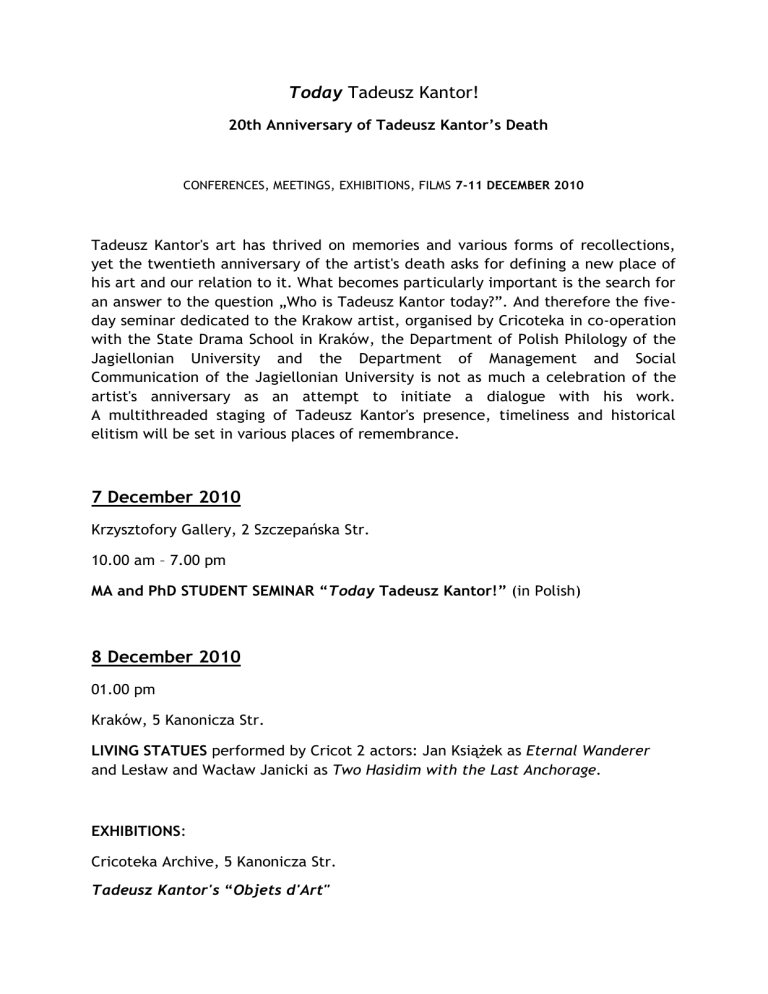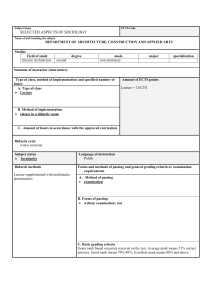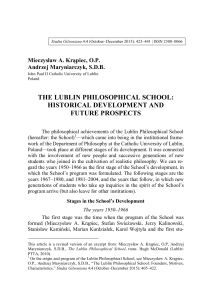
Today Tadeusz Kantor!
20th Anniversary of Tadeusz Kantor’s Death
CONFERENCES, MEETINGS, EXHIBITIONS, FILMS 7-11 DECEMBER 2010
Tadeusz Kantor's art has thrived on memories and various forms of recollections,
yet the twentieth anniversary of the artist's death asks for defining a new place of
his art and our relation to it. What becomes particularly important is the search for
an answer to the question „Who is Tadeusz Kantor today?”. And therefore the fiveday seminar dedicated to the Krakow artist, organised by Cricoteka in co-operation
with the State Drama School in Kraków, the Department of Polish Philology of the
Jagiellonian University and the Department of Management and Social
Communication of the Jagiellonian University is not as much a celebration of the
artist's anniversary as an attempt to initiate a dialogue with his work.
A multithreaded staging of Tadeusz Kantor's presence, timeliness and historical
elitism will be set in various places of remembrance.
7 December 2010
Krzysztofory Gallery, 2 Szczepańska Str.
10.00 am – 7.00 pm
MA and PhD STUDENT SEMINAR “Today Tadeusz Kantor!” (in Polish)
8 December 2010
01.00 pm
Kraków, 5 Kanonicza Str.
LIVING STATUES performed by Cricot 2 actors: Jan Książek as Eternal Wanderer
and Lesław and Wacław Janicki as Two Hasidim with the Last Anchorage.
EXHIBITIONS:
Cricoteka Archive, 5 Kanonicza Str.
Tadeusz Kantor's “Objets d'Art"
8.12.2010 – 01.00 pm – 04.00 pm , 9–10.12.2010 – 10.00 am – 02.00 pm
Exhibition of selected objects from Cricoteka collection used in performances of
The Dead Class (1975), Wielopole, Wielopole (1980) and Let the Artists Die (1985).
Tadeusz Kantor's Gallery – Atelier, 7/5 Sienna Str.
"Today Is My Birthday”. Drawings by Tadeusz Kantor
8.12.2010 – 02.00 pm – 04.00 pm , 9-10.12.2010 – 10.00 am – 02.00 pm
The exhibition comprises 27 drawings for the performance, made in the artist's
studio at Sienna Street in 1989-90, which are currently in the Cricoteka collection.
05.00 pm
Krzysztofory Gallery, 2 Szczepańska Str.
“to remember it all” – A MEETING WITH TADEUSZ KANTOR'S ACTORS (in Polish)
Moderator: Beata Guczalska
9 December 2010
State Drama School in Kraków, Sala Klasyczna, 5 Warszawska Str.
A CONFERENCE “TODAY TADEUSZ KANTOR!” (translation into English)
Day One
09.00 am
Opening Ceremony
Rector of the State Drama School in Kraków Ewa Kutryś / Director of Cricoteka
Natalia Zarzecka / Dean of the Department of the Management and Social
Communication of the Jagiellonian University, Professor Krzysztof Pleśniarowicz /
Dean of the Department of Polish Philology of the Jagiellonian University, Professor
Jacek Popiel
Screening of a fragment of Tadeusz Kantor’s speech during the symposium “Art
and Freedom” [„Sztuka i wolność”] at the Jagiellonian University in 1990
09.15 am
Andrzej Wełmiński Funkcja i znaczenie zespołu w procesie tworzenia spektakli
teatru Cricot 2 [The Function and Significance of the Ensemble in the Development
of Cricot 2 Productions]
Krzysztof Miklaszewski Aktor w teatrze Kantora – pytania i próby odpowiedzi [The
Actor in Kantor's Theatre – Questions and Tentative Answers]
Loriano Della Rocca „Tadeusz Kantor” Poland, Kraków, 8.12.1990-8.12.2010
Anna Halczak Cricoteka – „konieczność przekazywania” [Cricoteka – "The Necessity
of Transmission"]
Renato Palazzi La grandezza di Kantor: una scomoda eredità [Kantor's Greatness:
An Inconvenient Heritage]
11.45 am – 12.15 pm discussion
12.15 pm – 12.30 pm coffee break
12.30 pm
Cecile Coutin La Machine de l’ amour et de la mort de Tadeusz Kantor [The
Machine of Love and Death]
Uta Schorlemmer Absence Present in Tadeusz Kantor’s Work, in comparison with
Marina Abramović and Christoph Schlingensief
Jaromir Jedliński Wystawa “Beuys-Kantor. Pamięć” w Israel Museum w
Jerozolimie [“Beuys-Kantor. Memory.” An Exhibition at the Israel Museum in
Jerusalem]
Klaus Dermutz Tadeusz Kantor – Anselm Kiefer
02.30 pm – 03.00 pm discussion
03.00 pm – 04.00 pm lunch break
04.00 pm Afternoon session
Josep Maria Sagarra “Teatr emocji” Tadeusza Kantora. O recepcji sztuki Tadeusza
Kantora w Hiszpanii [Tadeusz Kantor's "Theatre of Emotion.” On the Reception of
Tadeusz Kantor's Art in Spain]
Teresa De Vido Rzewuska Tadeusz Kantor a słynni przodkowie: kilka paradoksów
[Tadeusz Kantor and Famous Ancestors: Selected Paradoxes]
Andrzej Turowski Powidoki [Afterimages]
Rafał Solewski Dziedzictwo i tożsamość w twórczości Tadeusza Kantora. Wobec
sztuki nowoczesnej [Heritage and Identity in Tadeusz Kantor's Work. Regarding
Contemporary Art]
06.00 pm – 06.30 pm discussion
06.30 pm – 06.45 pm coffee break
06.45 pm
Lech Stangret Rola rysunku w procesie kreacji automitologii Tadeusza Kantora
[The Role of Drawing in the Creation of Tadeusz Kantor's Self-Mythology]
Amos Fergombe La porte, le cadre ou le seuil transcendant dans les oeuvres de
Tadeusz Kantor [Door, Frame or Transcendent Threshold in the Work of Tadeusz
Kantor]
Jean-Pierre Thibaudat Autour de la photographie de Wielopole [About A
Photography of Wielopole]
08.15 pm – 08.45 pm discussion
09.00 pm
SCREENING OF “SACKS, WARDROBE AND UMBRELLA” [“Säcke, Schrank und
Schirm”], dir. Dietrich Mahlow, Saarländischer Rundfunk, 1968, 89’
In 1968 the performance of “The Wardrobe” (based on a play “The Country House”
by Stanisław Ignacy Witkiewicz), which Kantor produced in Baden-Baden in 1966,
was shot - a new staging with a different cast. Mahlow's film presents a model of
that 'informal' performance which Cricot 2 Theatre already staged in 1961. The
actors were their own dummies; hanged in the wardrobe on hangers, they would
utter random words. 'The action' of the film takes place in various places: on the
beach, in a railway station, in a casino, in the opera, at a shooting range, in a
castle...
10 December 2010
State Drama School in Kraków, Sala Klasyczna, 5 Warszawska Str.
A CONFERENCE “TODAY TADEUSZ KANTOR!” (translation into English)
Day Two
09.30 am
Wojciech Owczarski Teatr Snów w Teatrze Śmierci [The Theatre of Dreams in the
Theatre of Death]
Grzegorz Niziołek Lęk i co dalej... [Fear and What Next…]
Klaudiusz Święcicki Antropologia historii i pamięci w twórczości teatralnej
Tadeusza Kantora [The Anthropology of History and Memory in Tadeusz Kantor's
Theatre Work]
Marek Pieniążek Kantor – reaktywacje własnej realności. Ostatnie spektakle
Teatru Cricot 2 [Kantor - Reactivating One's Own Reality. Late Productions by
Cricot 2]
11.30 am – 12.00 pm discussion
12.00 pm – 12.15 pm coffee break
12.15 pm
Katarzyna Osińska Don Kichot jako artysta – w interpretacji Tadeusza Kantora
[Don Quixote as an Artist – as Interpreted by Tadeusz Kantor]
Anna Baranowa Wit Stwosz prototypem “artysty przeklętego”. O wątkach
stwoszowskich w spektaklu Tadeusza Kantora „Niech sczezną artyści” [Veit Stoss as
the Prototype of the "Accursed Artist." The Veit Stoss Motif in Tadeusz Kantor's
"Let the Artists Die"]
Dominika Łarionow Manekin Tadeusza Kantora i nadmarioneta Edwarda G.Craiga –
zarys idei [Tadeusz Kantor's Mannequin and Edward G. Craig's Ubermarionette – an
outline]
Anna R. Burzyńska Powroty nosorożca [Returns of the Rhinoceros]
02.15 pm – 02.45 pm discussion
02.45 pm – 03.45 pm lunch break
03.45 pm Afternoon session
Jan Kłossowicz Fabuły Kantora [Kantor's Plots]
Paweł Stangret Tadeusz Kantor czytany [Reading Tadeusz Kantor]
Michał Kobiałka Tadeusz Kantor’s Personal Confession: Notes on Late Style
05.15 pm – 05.45 pm discussion
05.45 pm – 06.00 pm coffee break
06.00 pm
Katarzyna Tokarska-Stangret „Non omnis moriar” artysty teatru [The "Non omnis
moriar" of a Stage Artist]
Zbigniew Osiński Trudna relacja Tadeusz Kantor – Jerzy Grotowski: dwie idee
teatru (sztuki) [The Difficult Relationship between Tadeusz Kantor and Jerzy
Grotowski: Two Visions of (Art) Theatre]
Krzysztof Pleśniarowicz Nasza klasa umarła. Co Tadeusz Słobodzianek wziął z
Kantora [Our Class is Dead. What Tadeusz Słobodzianek Took from Kantor]
Katarzyna Fazan Cienie polskiego Odysa. Początek i Koniec pewnej tradycji
teatralnej [Shades of the Polish Odysseus. The Beginning and End of a Certain
Theatre Tradition]
08.00 pm – 08.30 pm discussion
09.00 pm
SCREENING OF “LOVELIES AND DOWDIES”, dir. Ken McMullen, 1972, 30’
During its second tour of Edinburgh in 1973 by invitation of Richard Demarco,
Tadeusz Kantor's Cricot 2 presented “Lovelies and Dowdies”. Performances would
take place in the abandoned space of the Poor House, neighbouring the Greyfriars
cemetery, once indeed a poor house and a place with an incredible ambiance. Ken
McMullen shot it on 16 mm and in black and white and juxtaposed extracts from
the play with scenes filmed at the London's Smithfield meat market.
09.30 pm
MEETING WITH THE DIRECTOR. Moderator: Uta Schorlemmer
Ken McMullen is an artist, film director and a lecturer, who currently lives in
London. For the last thirty years, he has cooperated closely with many outstanding
figures (such as Joseph Beuys, Jacques Derrida, Tadeusz Kantor, Bernard Stiegler,
Maurice Jacob and Ian Hamilton Finlay), resulting in collaboration in film work, art
work and writing. He participated, among others, in exhibitions in MOMA in New
York, in Tate Modern in London and in Gubelkian in Lisbon and his films have been
presented at the most important international festivals, such as Cannes, Berlin and
San Sebastian.
11 December 2010
State Drama School in Kraków, Sala Klasyczna, 5 Warszawska Str.
A CONFERENCE “TODAY TADEUSZ KANTOR!”
Day Three
11.00 am – 01.00 pm
Stage Directors' Panel (in Polish)
Kantor in the Theatre – an Impossible Tradition
Participants: Ana Brzezińska, Anna Królica, Michał Borczuch, Andrzej Dziuk,
Krzysztof Garbaczewski, Paweł Passini, Andrzej Wajda, Marcin Wierzchowski.
Moderator: Anna R. Burzyńska
01.00 pm – 01.15 pm coffee break
01.15 pm
SCREENING OF “ATTENTION! PAINTING. TADEUSZ KANTOR PAINTING”, real. by
Mieczysław Waśkowski and Antoni Nurzyński, produced by Zespół Autorów
Filmowych “KADR” [Film Actors' Ensemble] and the National Higher School of
Film, Television and Theatre in Łódź, 1957, 9’
One of the first screenings of the film about Tadeusz Kantor's Informel painting
took place during the Second Exhibition of Modern Art in Warsaw in 1957. At the
time, the papers wrote, 'On the screen, there is a melee of bright splashes, vying
with one another, bursting and disapppearing, only to erupt anew, from a complete
greyness, in a frenetic gamut of colours. (…) Mieczysław Waśkowski and Antoni
Nurzyński have decided to bring back Tachism and to give it a fourth dimension:
time and movement. (…) In what category does this superinteresting experiment
belong? It certainly doesn't in any way fit into the criteria of looking at a painting
applied so far.’ A year later, the film was awarded a distinction at the First
International Competition for Films about Art, during the 29th Venice Biennale. A
copy of the film, for many years considered lost, was found in the Biennale
Archives.
01.30 pm - 03.30 pm
Curators' Panel (in Polish)
Kantor Exhibited - Returns, Reconstructions, Creations
Participants: Zofia Gołubiew, Wiesław Borowski, Jaromir Jedliński, Lech Stangret,
Jarosław Suchan, Marek Świca, Andrzej Turowski.
Moderator: Natalia Zarzecka
05.00 pm
SCREENING OF THE FILM “THE THEATRE OF TADEUSZ KANTOR” [„Le Théâtre de
Tadeusz Kantor”], real. by Denis Bablet, CNRS Audiovisuel, 1985, 144’
The film aims to capture the phenomenon of Tadeusz Kantor's theatre and it
contains ample fragments of his performances from the time of The Happening
Theatre and the Theatre of Death as well as unique recordings of rehearsals.
Talking to Denis Bablet, Kantor reveals his attitude to the art of the 20th century
and he explains the method of working on the performances as well as the concept
of Cricot 2 Theatre. The documentary covers Kantor's theatre work up to
Wielopole, Wielopole.
Academic coordinator of the symposium:
Katarzyna Fazan


